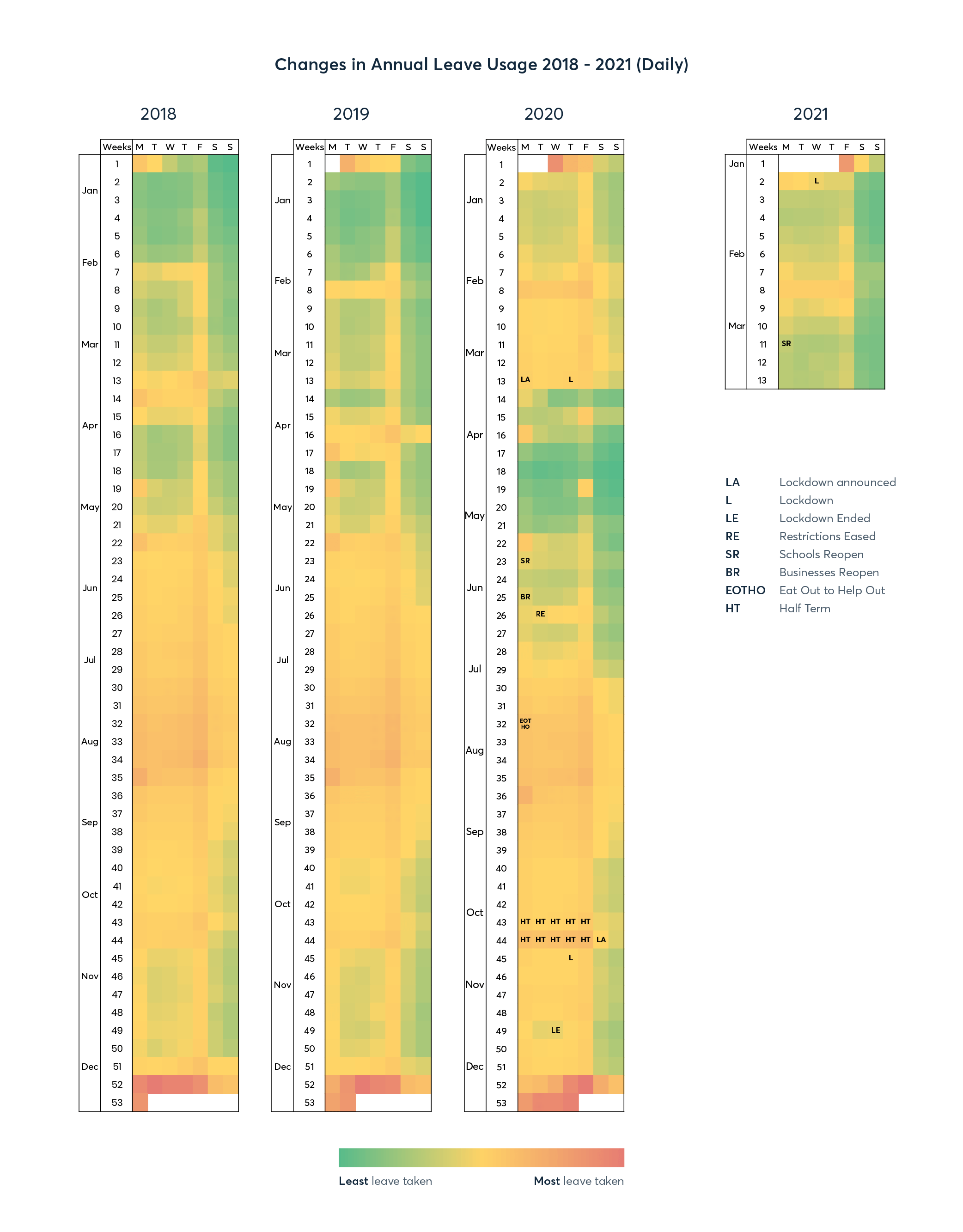2020 has changed how we use our annual leave.
Unsurprisingly, with nowhere to go, people took a lot less annual leave than usual last year. We’ve already discussed why this is a bad thing, but today we wanted to take a deeper look at the data and see if, as well as causing us to take less leave in general, 2020 has changed our holiday leave habits entirely.
We analysed the holiday leave patterns of 100,000 RotaCloud users to find out how exactly usage has changed from 2018 to 2021. In the heatmaps below we’ve illustrated these changes, and this post will further explore the potential reasons for the new trends we’re seeing emerge — and what we can do to prepare for them.

We’ll be looking at:
- The traditional holiday peaks and troughs, using data from 2018 and 2019
- Exactly what happened to annual leave usage in 2020, from the big picture to the minutiae of the most and least popular individual days off
- How we thought 2021 was going to go, based on what happened in 2020
- How 2021 is actually going so far
- How this will affect businesses, and how managers can use this info to better manage annual leave
If you just want to see the key stats, click here to jump straight to the bullet points at the end. In the course of our research we also came across some slightly quirkier data. For example, did you know that Tuesday used to be the day of the week that people were least likely to take as a holiday, but that it changed in 2020? Stats that while not necessarily adding much to this specific blog, we still found pretty interesting. So we’ve also included that data at the bottom of this piece too.
2018/2019
Traditionally in the UK, most people go on holiday in summer; they want Christmas and New Year off; no one wants to take leave in January or February; and Fridays are the most popular day to have off. This is pretty much established and has been for a long time. It’s not news to you.
The top five most popular days to take off in both 2018 and 2019 (excluding Christmas) were all in August around the bank holidays. The least popular were all in the second and third weeks of January. Overall, employees took about a third of their annual leave in Q3 alone (summer), about 27% of their leave in Q4 (including the Christmas/New Year period), and only 17% in Q1.
To summarise: employees were predictable.
But then came 2020...
2020
Unsurprisingly, leave usage in general was way down in 2020, especially in the second quarter of the year, and still lower than you’d expect in the summer period. There was a slight increase in leave uptake on normal levels in Q4, but not enough to make up for earlier falls. And by December 2020, the average person still had almost 14 days of annual leave left that they hadn’t managed to use.
As well as taking far less leave than normal, the periods during the year that people took their leave changed dramatically too. The first of the UK’s lockdowns was announced on the 23rd March 2020 and came into effect on the 26th. As you’d expect, holiday usage dropped sharply soon after. In the last weeks of March, annual leave was in fact up approximately 30% compared to the same period in 2019, but by the first week of April, annual leave was down 23%, and by mid-April it was down by 52%.
It wasn’t until the last week of July (20th July, specifically) until people really started taking significant amounts of holiday in 2020, with very little holiday taken comparatively in the three-and half-months from the start of April.

Similarly to previous years, August was still a busy time for leave, and the dates around the bank holiday continued to be the most popular time to have off. However, the fourth most popular day to have off in 2020 was October 30th. The October half-term is not usually a hugely busy time for holiday, but in 2020 we saw leave uptake increase significantly.
Elsewhere, the months of November and December, usually a quiet time for annual leave (outside of Christmas), were almost 12% busier in terms of holiday than they were in 2019.
As far as annual leave records go, 2020 threw us one heck of a curveball.
2021
We started the year assuming that 2021 was going to be quite the opposite, with people booking more holidays, and earlier, than ever before — indeed, in late 2020, we saw people booking time off for 2021 at a record-breaking rate, with double the number of people pre-booking their holidays than we’d seen in previous years.
But then another lockdown was announced, and we ended up seeing even fewer holidays taken in early 2021 than in pre-pandemic 2020.

That being said, compared with later in the year, we can see quite a lot of holiday booked in for the last weeks of March and first week of April. The first restrictions are due to ease on March 29th, and bank holidays are set to fall on the 2nd and 5th April, so perhaps this is to be expected.
And, by taking a closer, comparative view of leave booked throughout the whole year, we can see this illustrated in the chart below.

People are continuing to book their annual leave at a record rate. In March 2020, for example, only 9% of all people’s holidays had been booked in. This year, however, 33% of all holiday days for the year have already been booked.
Predictions
It’s hard to know where the holiday peaks will fall between April and December 2021. A lot will depend, of course, on any changes to restrictions as — as you can see from the charts — there is volatility around the dates of government announcements and rule changes.
We think, however, that in 2021 there will be more leave taken in the second and fourth quarters of the year than normal, with even more pronounced spikes in the summer. We’ll also see more shorter holidays as there will be less travel abroad.
It’s also important to note that the laws around holiday rollover changed in 2020 too, and staff whose leave is disrupted by Covid-19 are now allowed to carry over their leave into the following two years — so lots of people may have much more holiday accumulating than normal, meaning a potential flood of leave in 2022.
If lockdown doesn’t end as quickly as we expect, we’ll see less holiday taken. And, given that people already took far fewer holidays than they should have last year too, this isn’t a good thing. No matter what happens, you should be encouraging staff to take their leave, for their mental and physical health.
Key takeaways
2020
- In the last weeks of March 2020 leading up to lockdown, annual leave was up by 30% (compared to 2019)
- By April, leave rates had dropped by 52%
- The least popular days to take leave in the whole of 2020 were Tuesday 28th and Wednesday 29th April (excluding weekends)
- In the period April to July, very little holiday leave was taken. In 2019, from April to July approximately one-third (33%) of all leave was taken; in 2020, it was only 23%, down approximately 30% for the period overall
- October half term saw much more leave booked than usual
- Holidays in November and December were up 12% on usual levels
2021
- People pre-booked holidays for 2021, in 2020, at a record rate
- However, likely due to another lockdown, annual leave usage fell again in Q1 2021
- But leave booking for 2021 is still rising. In March 2020, only 9% of all people’s holidays had been booked in. In March 2021, however, 33% of all holiday days had already been booked. This means leave booking for 2021 is up, in general, by approximately 266%
Other interesting stats
- The least popular days to take off in the whole year used to be Tuesdays — specifically Tuesday 9th and Tuesday 15th January, but in 2020, it changed to Wednesdays. (Excluding weekends)
- The average person ends each working year with seven days of annual leave untaken! And in 2020 it was far higher: a study we conducted in early December 2020 found that people still had almost 14 days of holiday leave to take (compared with nine at the same time in 2019)
- The number of people pre-booking their holidays for the following year has skyrocketed. The amount of people that were pre-booking holidays in 2020, for 2021, doubled (compared to those pre-booking in 2019 for 2020). They’re also pre booking a greater number of days (up by 40%, from 7 days to 10 days)
Source: RotaCloud database. Data collected December 2020 and March 2021.
This study uses data from 100,000 RotaCloud users across the whole of the UK, working a variety of different working patterns and in a variety of different sectors. We have users in industries as diverse as hospitality and leisure, education, healthcare, retail, tech and professional services, amongst others.



